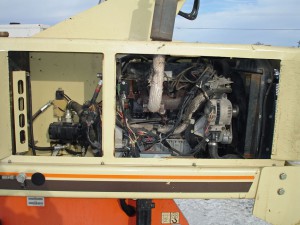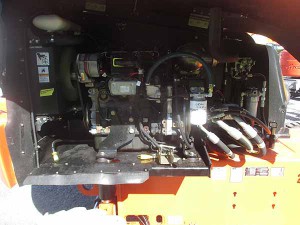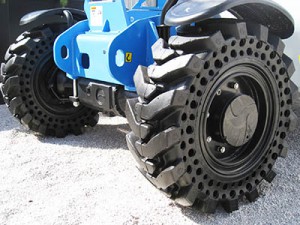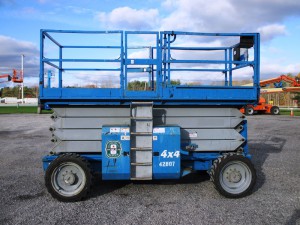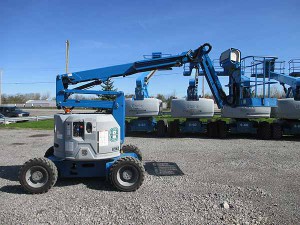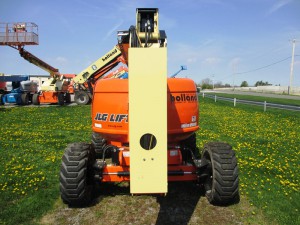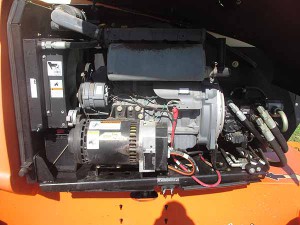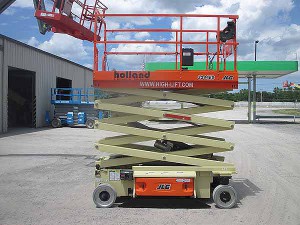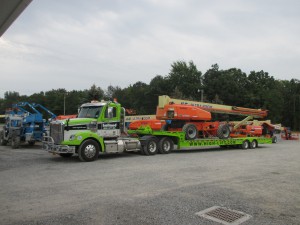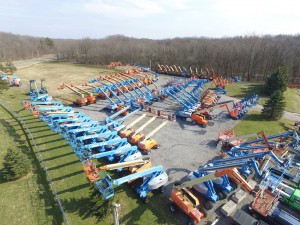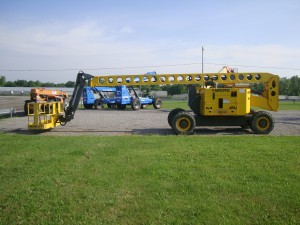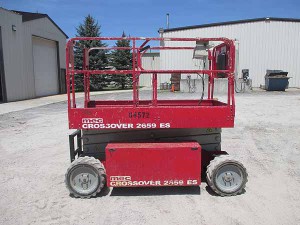
If you asked someone that used aerial lifts during the mid 1980’s through late 90’s if they’d prefer to use a diesel or a gas (gas/propane) lift 90% would have said diesel and possibly here some profanity. If you questioned people that owned them they’d tell you the only way they’d want gas power is if the lift was much cheaper or they had to use the lift inside regularly. Basically the gas powered lifts weren’t popular. The reason was lack of reliability and expense to keep them running. They just didn’t work well.
Somewhat oddly this wasn’t a much of a problem in the 1970’s and early 80’s. The earliest gas powered lifts tended to have simple Wisconsin brand engines. They’d have a carburetor with a manual choke that you’d pull out by hand or by pushing a button. This was a little bit of a pain when it was cold but it was simple. People still preferred diesel because they were better on fuel, more powerful, and lasted longer; but the gas machines weren’t hated. It was just an inconvenience.
It started to be common for American cars to be fuel injected in the early 1980’s which improved performance, starting, and reliability but the technology was still fairly expensive and the lift manufacturers tried to avoid that with a half step. Basically the lifts started to have pretty complicated carburetors with automatic choking systems. They combined this with governors that would rev the engine up and down based on power requirements. During these years Ford supplied most of the engines though different manufacturers chose different carburetor and governor systems. The problem with all these systems to some degree is the governors would fail frequently and were expensive. Some of the carburetors themselves also got to be well over $1000 to replace and more complicated to work on. Combined with a few other components the systems tied to the carburetors and governor could be $3000-4000 of parts alone. Beyond the reliability and cost issues the automatic choke could be problematic. Picture a very cold day. After some cranking the lift finally starts. You should let it run for 10-15 minutes to warm up but you’re cold and want to get the job done. You jump on and drive 2 feet and it stalls. No problem, just restart it. It won’t start. The choke got just too warm and thinks it should be off. Sit and wait until it will work again. These factors created a very negative view of gasoline engines.
Starting in the late 90’s manufacturers finally started moving to a simple fuel injection system. Overnight things improved markedly even though most of these engines were just an updated version of the same Ford. The engines now made significantly more power, they started better, and were most importantly much more reliable. The gasoline engines also were significantly cheaper for service parts with many items even available at auto parts stores. A funny thing happened though, nobody wanted them. People had gotten so fed up with gas machines in the previous 15 years that you had a hard time even getting a customer to try a gas lift. At the same time better and bigger electric powered lifts started to arrive on the market. However clean the exhaust on a gas/propane powered lift might be electric is cleaner and with their arrival one of the major holdouts of using gas was gone. Both equipment companies and end users figured if they did an indoor job they’d use an electric so the market for the gas lifts shrunk even more. It’s pretty common to see used lifts for sale where a gasoline model brings 20-30% less than an equivalent diesel even though new they cost roughly the same.
Basically this brings us up to a few years ago. What’s changed? EPA regulations. It’s getting harder and more expensive to get the diesel engines to pass regulations. They now have to run hotter to burn fuel cleaner and this added significant expense both to the price of a new lift and maintenance of it. Expensive mufflers that help filter out exhaust have replaced a simple muffler that only worried about making things a little quieter. On the other hand it didn’t take nearly as much work to make a gasoline powered lift past regulations and they’ve also gotten better on fuel use. As these more complicated diesel lifts age will we see people start to consider gas power in a positive light again, if only to avoid a lot of complication?
A final X factor are hybrid lifts. Models like JLG’s M600JP have batteries along with a small diesel engine. The engine is small enough that it’s easy to pass regulations (at this point) and the battery system works to make up for some of the power loss. It basically works like many current plug in hybrid cars. Current technology doesn’t make them equal to lift with a full sized diesel or gas engine, especially in drive performance, but overtime they’re likely to close the gap some.
Gas/Propane, diesel, hybrid, and electric are all going to be part of the mix for the foreseeable future but it will be interesting to see where the market shares head or if a new technology gains traction.
